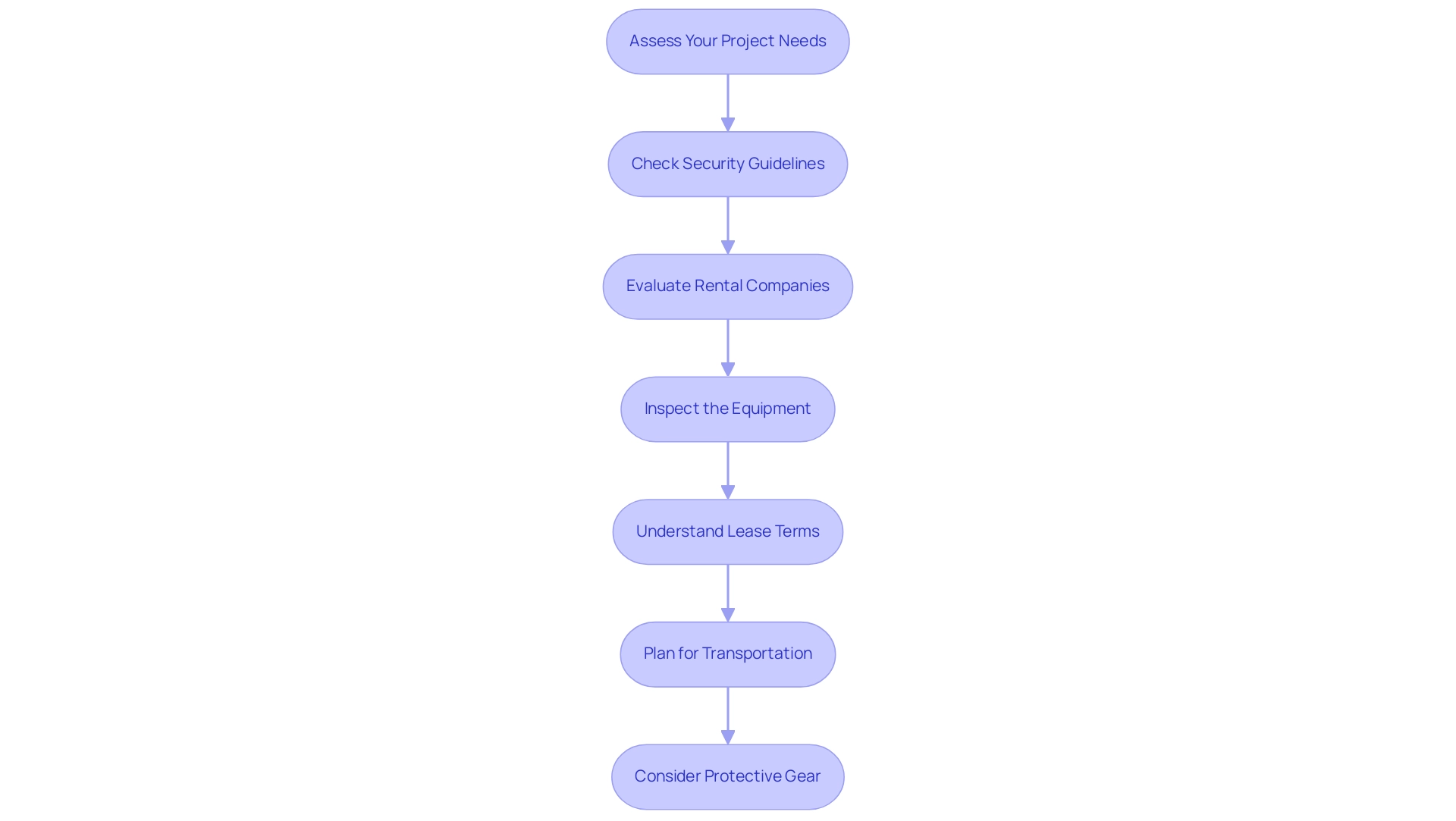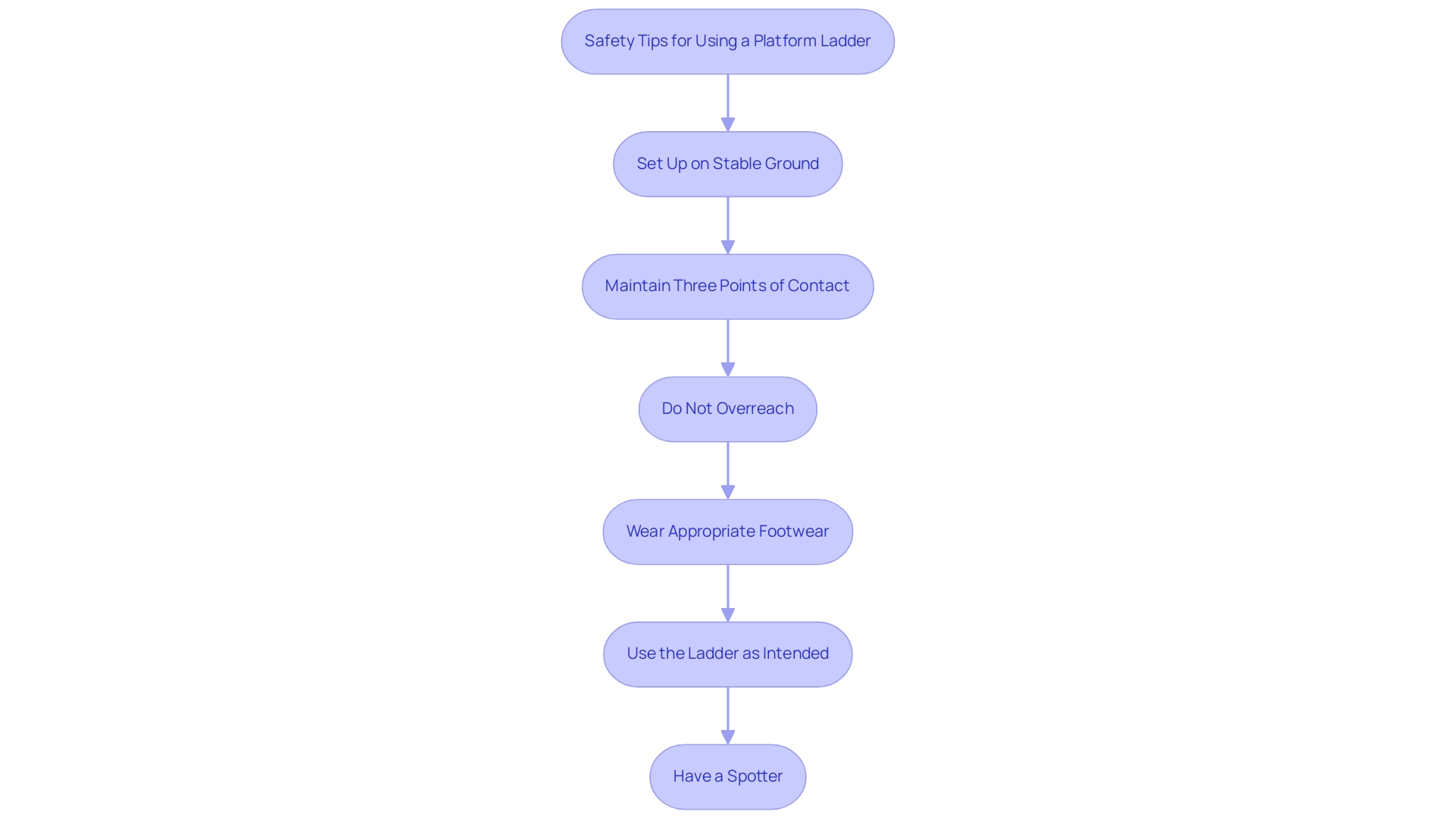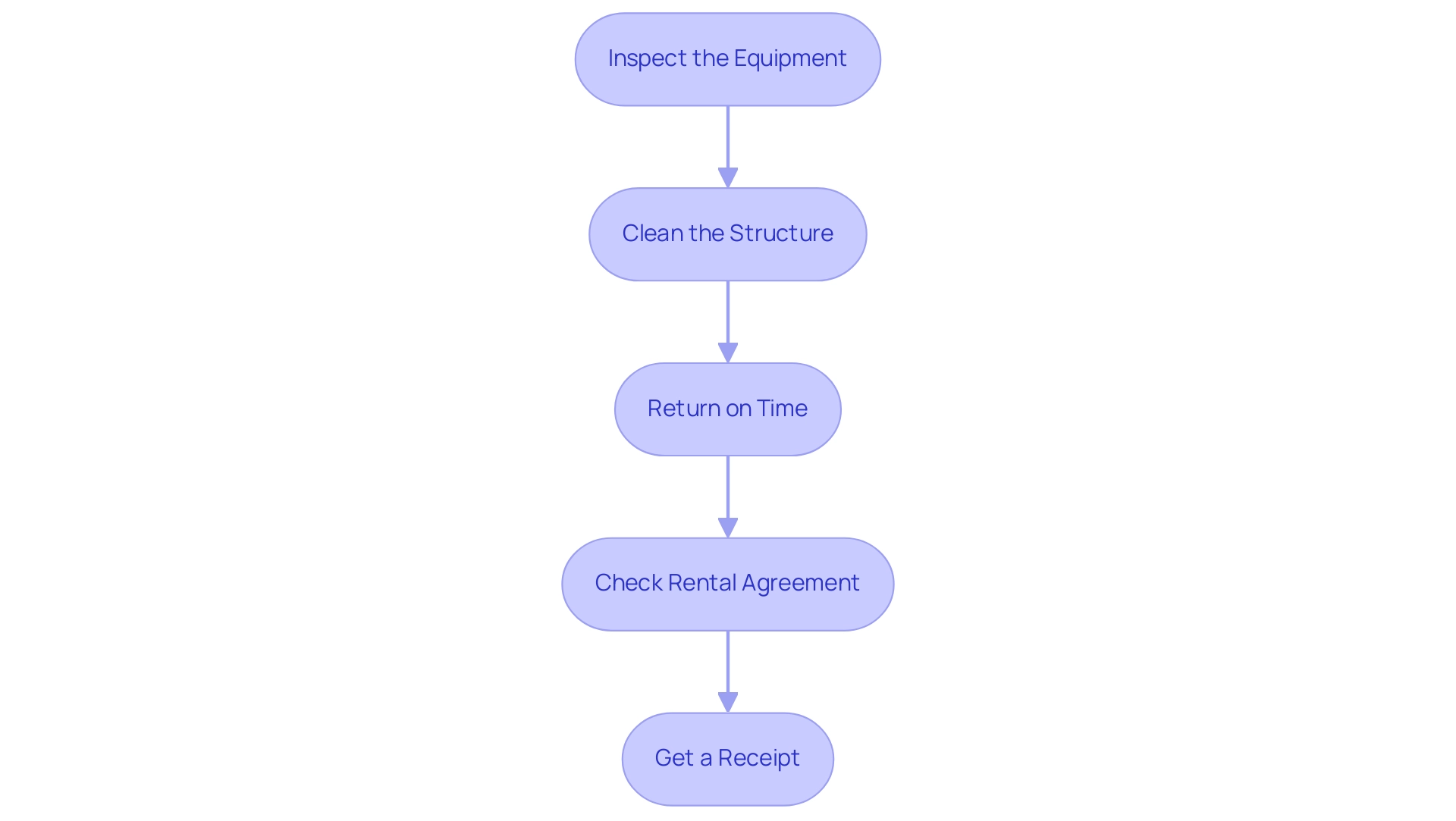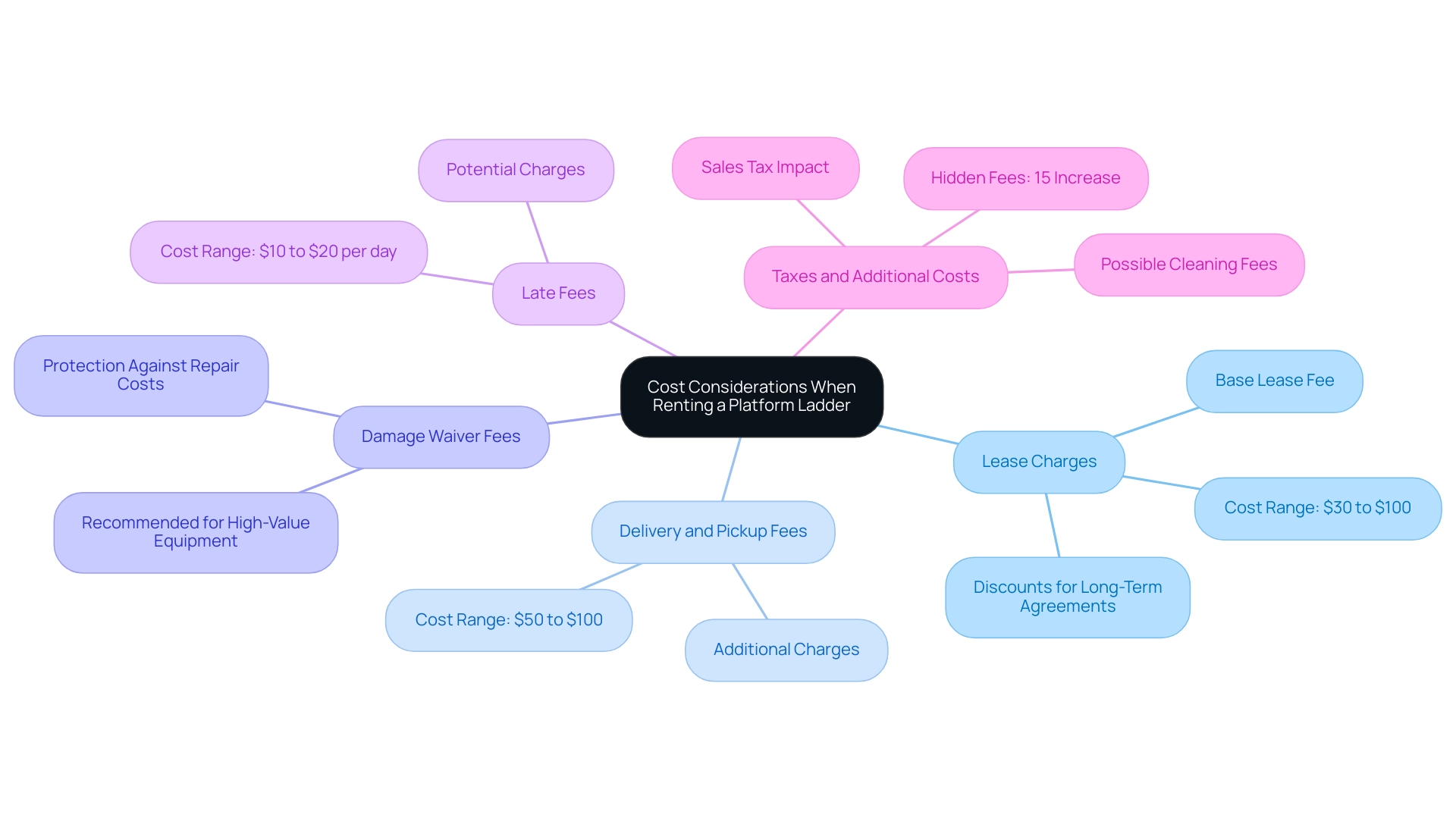Introduction
In the world of construction, ensuring safety and efficiency often hinges on the proper selection and use of equipment, particularly when it comes to platform ladders. With a myriad of options available for rental, understanding the essential steps to take before renting, the types of ladders suited for various tasks, and the safety measures to implement is crucial for project managers.
Navigating the complexities of ladder rentals can pose challenges, from assessing project needs to managing costs and adhering to safety regulations. By equipping oneself with the right knowledge and strategies, construction professionals can enhance their operational effectiveness while prioritizing the safety of their teams.
Essential Steps to Consider Before Renting a Platform Ladder
Before renting a platform ladder, it is crucial to take several key steps to ensure safety and compliance with regulations:
- Assess Your Project Needs: Start by determining the height and nature of the work you will be performing. This evaluation is crucial in directing you towards the appropriate size and type, ensuring that it meets the requirements of your project.
- Check Security Guidelines: Familiarize yourself with local and national regulations concerning step stool use. Adhering to these standards is crucial in preventing accidents, particularly given that a significant percentage of injuries from falls arise from improper usage. As noted by PubMed.gov, "Given the 50 percent increase in ladder-related injuries during the study period, the relatively high likelihood of hospital admission, and the predominance of injuries in non-occupational settings, increased efforts are needed to prevent ladder-related injuries." This emphasizes the urgency of following safety practices, especially since 1% of injuries involving these structures are caused by losing grip, underscoring the significance of proper usage.
- Evaluate Rental Companies: Conduct thorough research on various equipment rental companies in your area. Search for trustworthy suppliers that provide a varied selection of climbing equipment and have received favorable customer feedback. This can assist in choosing a provider that emphasizes security and reliability in their rent platform ladder.
- Inspect the Equipment: Prior to rental, always conduct an inspection of the apparatus. Look for any signs of wear, damage, or defects that could compromise safety during use. Ensuring that the ladder is in optimal condition can significantly mitigate the risk of injuries, which, in 2022 alone, resulted in over 1,119 medically consulted injuries every 10 minutes in the U.S.
- Understand Lease Terms: Carefully read the lease agreement to grasp the terms and conditions. Pay particular attention to lease duration, costs, and any additional fees that may apply. Understanding the return policy and your responsibilities regarding damage or loss is crucial for a smooth experience when using a rent platform ladder.
- Plan for Transportation: Finally, consider the logistics of moving the equipment to your project site. Ensure that your vehicle can safely accommodate the ladder’s size and weight to avoid any mishaps during transit.
- Consider Protective Gear: Although OSHA does not mandate certain protective equipment like vests or hard hats in warehouses, their use is recommended to prevent injuries. Employers should consider implementing equipment policies to enhance worker protection in environments with moving machinery.
By following these steps, construction managers can improve security and ensure adherence to equipment leasing regulations, ultimately contributing to a more secure work environment.

Exploring Different Types of Platform Ladders for Rent
When considering ladder rentals for construction projects, it is essential to understand the various types of platform ladders available to ensure safety and efficiency:
- Rolling Platform Steps: These structures are designed for mobility, featuring wheels that allow for easy movement across flat surfaces. Their design is particularly advantageous for large projects where frequent relocation is necessary, making tasks more efficient. According to industry statistics, rolling platform steps have seen a 30% increase in usage over the past two years, highlighting their growing preference in construction.
- Fixed Platform Structures: Providing a stable working surface, fixed systems are perfect for tasks that necessitate extended use at a particular height. Commonly seen in construction and maintenance, these structures provide a secure base for workers needing to focus on detailed tasks. Construction expert John Doe emphasizes that 'fixed platform structures are crucial for safety in environments where stability is non-negotiable.'
- Multi-Position Equipment: Known for their versatility, multi-position equipment can be adjusted for various heights and angles. This adaptability renders them appropriate for a variety of tasks, accommodating managers who need flexibility in their solutions. Current trends indicate that multi-position tools are being employed in 45% of construction endeavors because of their multifunctional abilities.
- Step Stools with Platforms: These standard step stools come equipped with a platform at the top, providing enhanced stability for tasks performed at height. They are especially beneficial for indoor tasks where space might be limited, guaranteeing security without compromising accessibility. A case study on indoor renovations demonstrated that utilizing step stools with platforms decreased accidents by 25%.
- Extension Structures with Platforms: Capable of reaching considerable heights, extension structures often include platforms for enhanced security. They are especially suited for outdoor applications, including roofing and other high-reach tasks, where secure footing is critical. Experts suggest these structures for tasks needing elevation beyond 20 feet, highlighting that they offer essential protective features for workers.
Comprehending these varieties of rent platform ladder steps allows you to choose the most suitable choice for your requirements. The most recent trends suggest an increasing need for mobile platform steps in large-scale undertakings, with specialists highlighting their advantages in boosting productivity and ensuring worker protection. By making informed choices about equipment rentals, project managers can significantly improve efficiency while maintaining a safe working environment.
Safety Tips for Using a Platform Ladder
To ensure the safe usage of a platform stepping tool, especially during National Ladder Safety Month, adhere to the following essential safety tips:
-
Set Up on Stable Ground: Always position the equipment on a flat, stable surface. Uneven or slippery ground can lead to accidents, as nearly 40% of injuries related to these tools stem from them sliding out at the base due to incorrect setup angles.
Maintain Three Points of Contact: When climbing or descending, always keep two hands and one foot, or two feet and one hand, in contact with the rings. This practice significantly reduces the risk of falls, which are preventable, as noted by safety expert Paul Kupyna.
-
Do Not Overreach: Avoid leaning too far to one side while on the step stool. Instead of stretching, move the equipment closer to your work area. This simple step can prevent accidents and ensure your balance remains steady.
-
Wear Appropriate Footwear: Equip yourself with shoes that have non-slip soles. Proper footwear enhances traction and stability, making it easier to maintain your footing on the ladder.
-
Use the Ladder as Intended: Always adhere to the manufacturer’s guidelines regarding weight limits and usage specifications. Overloading or misusing the equipment can lead to catastrophic failures.
-
Have a Spotter: If possible, enlist the help of a colleague while using the step stool. A spotter can offer extra stability and support, further reducing risks linked to using a rent platform ladder.
-
Stay Informed: Be aware of recent incidents, such as the recent news about a worker falling from a height, to understand the real-world consequences of neglecting safety measures.
By following these guidelines, construction project managers can significantly enhance safety compliance and reduce the likelihood of related accidents on site.

Returning the Platform Ladder: Key Considerations
When returning a platform step, it’s crucial to follow a systematic approach to ensure a smooth return process and avoid any disputes or additional charges. Here are key considerations to keep in mind:
-
Inspect the Equipment: Conduct a thorough inspection of the structure for any signs of damage or wear.
Take detailed photographs of any issues to document its condition, which can be invaluable in resolving disputes over damages. Jakob Thygerson, an outdoor adventure seeker and engineer, emphasizes the importance of this step, noting that careful inspection can prevent misunderstandings at return time. In fact, statistics indicate that approximately 15% of conflicts in equipment leases arise from vague terms at the time of return.
-
Clean the Structure: Ensure that the structure is free from debris, dirt, or any materials that could affect its condition upon return. A clean ladder not only meets the company's standards but also reflects your professionalism as a project manager.
-
Return on Time: Adhering to the agreed-upon return date is essential to avoid late fees.
If additional time is needed, proactively reach out to the leasing company to discuss potential extensions or options, as many firms appreciate transparent communication. Research indicates that late returns can incur fees that average around 20% of the borrowing cost, underscoring the importance of timely returns.
-
Check Rental Agreement: Familiarize yourself with the rental agreement, as it may contain specific instructions regarding the return process.
This includes details on whether the equipment should be returned in person or dropped off, along with any associated fees that may apply to late returns.
-
Get a Receipt: Request a receipt or confirmation when you return the item. This documentation serves as proof that you returned the equipment in good condition and on time, safeguarding you against potential charges or disputes in the future.
Maintaining a record of this transaction can be essential, particularly in situations where leasing companies have strict return policies.
By adhering to these guidelines, construction project managers can navigate the equipment leasing process more effectively, minimizing common issues and ensuring a seamless return experience. Additionally, recent case studies emphasize that clear communication and adherence to return protocols can significantly reduce the likelihood of disputes, fostering better relationships with leasing companies.

Cost Considerations When Renting a Platform Ladder
When preparing a budget for renting a platform ladder, it's crucial to consider several cost factors to avoid unexpected expenses:
- Lease Charges: Get to know the base lease fee, which can vary depending on the kind of equipment and the duration of the lease. Many companies provide discounts for long-term agreements, so don’t hesitate to inquire about these options. For example, a recent cost analysis showed that while basic platform steps might range from $30 to $60 per day, premium models can reach up to $100, depending on the leasing company.
- Delivery and Pickup Fees: Be aware that some leasing services impose additional charges for delivering and picking up the equipment. It's wise to inquire about these fees upfront to ensure they are included in your budget calculations. According to industry insights, these charges can increase an average of $50 to $100 to your overall costs, depending on the distance from the leasing location.
- Damage Waiver Fees: Evaluate the option of purchasing damage waivers, which can safeguard you from incurring repair costs if the equipment sustains damage while in your possession. This can be a prudent financial decision, especially for high-value equipment. As noted by Daniel Murphy, "Understanding the risks associated with equipment leasing is essential, and a damage waiver can provide peace of mind in high-stakes environments."
- Late Fees: Understand the potential for late fees if the equipment is not returned as per the stipulated timeline. A thorough review of the lease agreement will help you avoid any unpleasant surprises and maintain good standing with the leasing company. Late fees can often range from $10 to $20 per day, adding up quickly if not monitored.
- Taxes and Additional Costs: Don’t overlook the impact of sales tax and other possible charges, such as cleaning fees if the equipment is returned in less than satisfactory condition. These additional costs can significantly affect your overall budget. For example, hidden fees can sometimes increase your total leasing cost by 15% or more.
By carefully considering these factors and referencing real-world examples, such as the budgeting strategies used in recent construction projects, you can effectively prepare your budget and make informed decisions when selecting a rent platform ladder.

Conclusion
Selecting the right platform ladder for construction projects is a multifaceted process that requires careful consideration of various factors. By assessing project needs, understanding safety regulations, evaluating rental companies, and inspecting the equipment, project managers can significantly enhance workplace safety and compliance. The knowledge of different types of ladders—such as rolling, fixed, and multi-position ladders—equips professionals to choose the most suitable option for their specific tasks, ensuring both efficiency and safety.
Moreover, implementing essential safety tips during ladder use, such as maintaining three points of contact and using the ladder as intended, is vital in preventing accidents. Following a systematic approach when returning the ladder, including thorough inspections and timely returns, can help avoid disputes and additional charges.
Lastly, being mindful of the cost considerations associated with ladder rentals, including delivery fees and damage waivers, allows for better budgeting and financial planning. By adopting these strategies, construction professionals can optimize their ladder rental experience, ensuring their projects are executed safely, efficiently, and within budget. Prioritizing these aspects not only enhances operational effectiveness but also fosters a culture of safety within the team, ultimately leading to successful project outcomes.
Frequently Asked Questions
What are the key steps to take before renting a platform ladder?
Key steps include assessing your project needs, checking security guidelines, evaluating rental companies, inspecting the equipment, understanding lease terms, planning for transportation, and considering protective gear.
Why is it important to assess project needs before renting a ladder?
Assessing project needs helps determine the appropriate size and type of ladder required for the height and nature of the work, ensuring it meets project requirements.
What security guidelines should be checked before using a ladder?
Familiarize yourself with local and national regulations regarding step stool use to prevent accidents, as improper usage is a significant cause of ladder-related injuries.
How can I evaluate rental companies for platform ladders?
Conduct thorough research on local equipment rental companies, looking for trustworthy suppliers with a good selection of climbing equipment and positive customer feedback.
What should I inspect before renting a platform ladder?
Always inspect the ladder for signs of wear, damage, or defects that could compromise safety during use.
What is important to understand regarding lease terms?
Carefully read the lease agreement to understand terms, costs, additional fees, return policies, and responsibilities regarding damage or loss.
How should I plan for transportation of the rented ladder?
Ensure your vehicle can safely accommodate the size and weight of the ladder to avoid mishaps during transit.
Is protective gear necessary when using a platform ladder?
While not mandated by OSHA in certain environments, using protective equipment like vests or hard hats is recommended to prevent injuries.
What types of platform ladders are available for rent?
Types include rolling platform steps, fixed platform structures, multi-position equipment, step stools with platforms, and extension structures with platforms.
What are the advantages of rolling platform steps?
They are designed for mobility with wheels, making them suitable for large projects requiring frequent relocation, and have seen a 30% increase in usage in recent years.
When should fixed platform structures be used?
They are ideal for tasks requiring extended use at a specific height, providing a stable working surface essential for safety.
What are the benefits of multi-position equipment?
These ladders are versatile and can be adjusted for various heights and angles, making them suitable for a range of tasks.
How do step stools with platforms enhance safety?
They provide enhanced stability for tasks performed at height, particularly beneficial for indoor tasks where space may be limited.
What are extension structures used for?
They are designed to reach considerable heights, often including platforms for security, and are suitable for outdoor applications like roofing.




